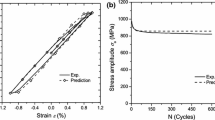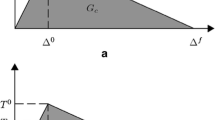Abstract
In this study, fatigue damage is combined with a cohesive zone model to simulate fatigue crack growth along the interface between dissimilar materials under repeated loadings. An evolution equation for fatigue damage is considered for the degradation of materials in a failure process zone. The potential-based Park–Paulino–Roesler cohesive model is employed to correctly consider mixed modes in the relationships between cohesive tractions and crack opening separations. Numerical examples show that the present method can predict properly fatigue crack growth along the interface between dissimilar materials under repeated loadings.












Similar content being viewed by others
References
Z.H. Jin, G.H. Paulino, R.H. Dodds, Cohesive fracture modeling of elastic-plastic crack growth in functionally graded materials. Eng. Fract. Mech. 70(14), 1855–1912 (2003)
P.W. Harper, S.R. Hallett, A fatigue degradation law for cohesive interface elements—development and application to composite materials. Int. J. Fatigue 32(11), 1774–1787 (2010)
B. Landry, G. LaPlante, Modeling delamination growth in composites under fatigue loadings of varying amplitudes. Compos. B 43(2), 533–541 (2012)
M. May, S.R. Hallett, A combined model for initiation and propagation of damage under fatigue loading for cohesive interface elements. Compos. A 41(12), 1787–1796 (2010)
A. Turon, J. Costa, P.P. Camanho, C.G. Davila, Simulation of delamination in composites under high-cycle fatigue. Compos. A 38(11), 2270–2282 (2007)
T.L. Anderson, Fracture Mechanics: Fundamentals and Applications, 3rd edn. (CRC Press, Boca Raton, 2005), pp. 25–61
D.S. Dugdale, Yielding of steel sheets containing slits. J. Mech. Phys. Solids 8(2), 100–104 (1960)
G.I. Barenblatt, The mathematical theory of equilibrium cracks in brittle fracture. Adv. Appl. Mech. 7, 55–129 (1962)
A. Hillerborg, M. Modeer, P.E. Petersson, Analysis of crack formation and crack growth in concrete by means of fracture mechanics and finite elements. Cement Concr. Res. 6, 773–782 (1976)
Z.Y.J. Zhang, G.H. Paulino, Cohesive zone modeling of dynamic failure in homogeneous and functionally graded materials. Int. J. Plast. 21(6), 1195–1254 (2005)
M.J. van den Bosch, P.J.G. Schreurs, M.G.D. Geers, An improved description of the exponential Xu and Needleman cohesive zone law for mixed-mode decohesion. Eng. Fract. Mech. 73(9), 1220–1234 (2006)
A. Needleman, A continuum model for void nucleation by inclusion debonding. J. Appl. Mech. 54(3), 525–531 (1987)
V. Tvergaard, J.W. Hutchinson, The influence of plasticity on mixed-mode interface toughness. J. Mech. Phys. Solids 41(6), 1119–1135 (1993)
X.P. Xu, A. Needleman, Void nucleation by inclusion debonding in a crystal matrix. Model. Simul. Mater. Sci. Eng. 1(2), 111–132 (1993)
L. Bankssills, Y. Bortman, A mixed-mode fracture specimen—analysis and testing. Int. J. Fract. 30(3), 181–201 (1986)
K. Park, G.H. Paulino, Cohesive zone models: a critical review of traction-separation relationships across fracture surfaces. Appl. Mech. Rev. 64(6), 1 (2011)
V. Tvergaard, Material failure by void growth to coalescence. Adv. Appl. Mech. 27, 83–151 (1990)
A. Needleman, An analysis of tensile decohesion along an interface. J. Mech. Phys. Solids 38(3), 289–324 (1990)
K. Park, G.H. Paulino, J.R. Roesler, A unified potential-based cohesive model of mixed-mode fracture. J. Mech. Phys. Solids 57(6), 891–908 (2009)
K.L. Roe, T. Siegmund, An irreversible cohesive zone model for interface fatigue crack growth simulation. Eng. Fract. Mech. 70(2), 209–232 (2003)
A. Abdul-Baqi, P.J.G. Schreurs, M.G.D. Geers, Fatigue damage modeling in solder interconnects using a cohesive zone approach. Int. J. Solids Struct. 42(3–4), 927–942 (2005)
M. Erinc, P.J.G. Schreurs, M.G.D. Geers, Integrated numerical–experimental analysis of interfacial fatigue fracture in SnAgCu solder joints. Int. J. Solids Struct. 44(17), 5680–5694 (2007)
M. Erinc, T.M. Assman, P.J.G. Schreurs, M.G.D. Geers, Fatigue fracture of SnAgCu solder joints by microstructural modeling. Int. J. Fract. 152(1), 37–49 (2008)
M. Erinc, P.J.G. Schreurs, M.G.D. Geers, Intergranular thermal fatigue damage evolution in SnAgCu lead-free solder. Mech. Mater. 40(10), 780–791 (2008)
Q.D. Yang, M.D. Thouless, Mixed-mode fracture analyses of plastically-deforming adhesive joints. Int. J. Fract. 110(2), 175–187 (2001)
J.R. Reeder, J.H. Crews, Mixed-mode bending method for delamination testing. AIAA J. 28(7), 1270–1276 (1990)
M.L. Benzeggagh, M. Kenane, Measurement of mixed-mode delamination fracture toughness of unidirectional glass/epoxy composites with mixed-mode bending apparatus. Compos. Sci. Technol. 56(4), 439–449 (1996)
Acknowledgements
This work was supported by the National Research Foundation of Korea (NRF) grant funded by the Korea government (MSIT) (No. 2018R1A2B6006234).
Author information
Authors and Affiliations
Corresponding author
Additional information
Publisher's Note
Springer Nature remains neutral with regard to jurisdictional claims in published maps and institutional affiliations.
Rights and permissions
About this article
Cite this article
Choi, YH., Kim, HG. Development of a Cohesive Zone Model for Fatigue Crack Growth. Multiscale Sci. Eng. 2, 42–53 (2020). https://doi.org/10.1007/s42493-020-00034-5
Received:
Revised:
Accepted:
Published:
Issue Date:
DOI: https://doi.org/10.1007/s42493-020-00034-5




